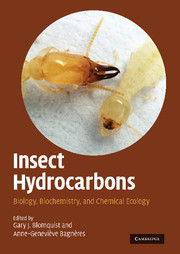Book contents
- Frontmatter
- Contents
- List of contributors
- Foreword
- Acknowledgments
- Part I Chemistry, Biochemistry, and Physiology
- 1 Introduction: history and overview of insect hydrocarbons
- 2 Structure and analysis of insect hydrocarbons
- 3 Biosynthesis of cuticular hydrocarbons
- 4 Molecular biology and genetics of hydrocarbon production
- 5 Site of synthesis, mechanism of transport and selective deposition of hydrocarbons
- 6 Cuticular lipids and water balance
- 7 Chemical taxonomy with hydrocarbons
- 8 Chemical synthesis of insect cuticular hydrocarbons
- 9 Oxygenated derivatives of hydrocarbons
- Part II Chemical Communication
- Index
4 - Molecular biology and genetics of hydrocarbon production
from Part I - Chemistry, Biochemistry, and Physiology
Published online by Cambridge University Press: 18 May 2010
- Frontmatter
- Contents
- List of contributors
- Foreword
- Acknowledgments
- Part I Chemistry, Biochemistry, and Physiology
- 1 Introduction: history and overview of insect hydrocarbons
- 2 Structure and analysis of insect hydrocarbons
- 3 Biosynthesis of cuticular hydrocarbons
- 4 Molecular biology and genetics of hydrocarbon production
- 5 Site of synthesis, mechanism of transport and selective deposition of hydrocarbons
- 6 Cuticular lipids and water balance
- 7 Chemical taxonomy with hydrocarbons
- 8 Chemical synthesis of insect cuticular hydrocarbons
- 9 Oxygenated derivatives of hydrocarbons
- Part II Chemical Communication
- Index
Summary
Hydrocarbons (HC) act as pheromones in a variety of orders including the Dictyoptera (Jurenka et al., 1989; Schal et al., 1994; Lihoreau and Rivault, 2009), Coleoptera (Ginzel et al., 2003, 2006), Hymenoptera (Howard, 1993; Le Conte and Hefetz, 2008), Diptera (Carlson et al., 1971; Antony and Jallon, 1982; Blomquist et al., 1987) and several lepidopteran species (Roelofs and Cardé 1971; Millar, 2000). In most insects, they are present on the cuticle and are synthesized in large cells called oenocytes located within or under the abdominal integument (Diehl, 1975; Ferveur et al., 1997; Schal et al., 1998; Fan et al., 2003). In Lepidoptera, their synthesis occurs in tissues associated with the abdominal tegument (possibly oenocytes), and they are then released into a sex pheromone gland (Schal et al., 1998).
Hydrocarbons have long straight or methyl-branched chains (C19 to C40) that may be unsaturated or saturated and, depending on the chain length, are either volatile (in Lepidoptera: Roelofs and Cardé 1971) or act over short distances or by contact (in other orders). Their biosynthesis has been studied by the use of radiolabeled precursors and the biosynthetic pathways have been established (Dillwith et al., 1981, 1982; Blomquist et al., 1987). Pathways involve the following: the synthesis of medium-chain fatty acids by a fatty acid synthetase (FAS), their desaturation by desaturase(s) followed by their elongation to very-long-chain fatty acids by elongase(s), and then decarboxylation to hydrocarbons.
- Type
- Chapter
- Information
- Insect HydrocarbonsBiology, Biochemistry, and Chemical Ecology, pp. 53 - 74Publisher: Cambridge University PressPrint publication year: 2010
- 30
- Cited by



